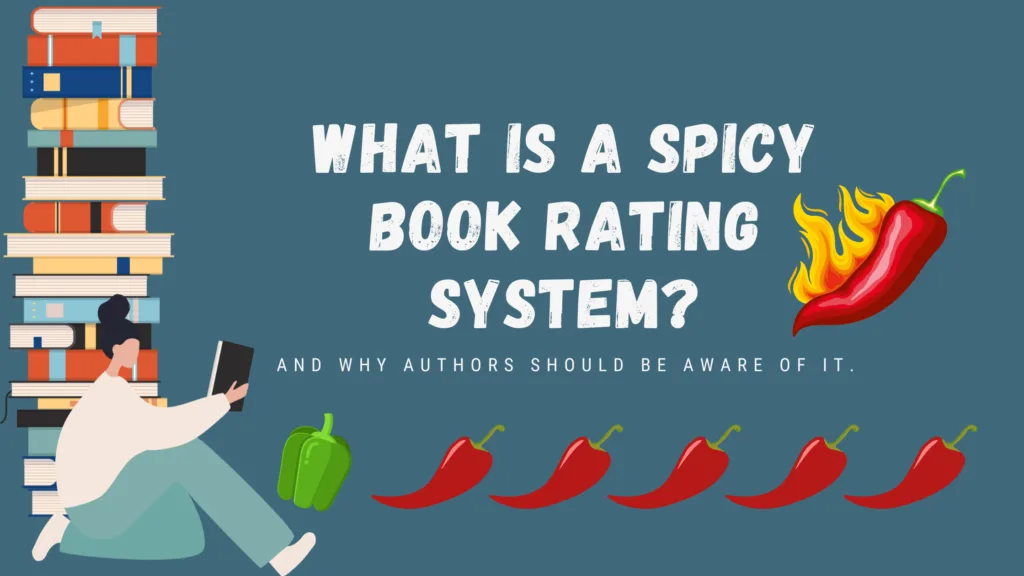If you’ve ever dived into the world of romance books or stumbled across a BookTok recommendation, you’ve probably heard the term “spicy” thrown around. But what exactly does it mean? And what is this spicy book rating system readers and reviewers keep referencing? Well, for February, the month of “love,” we’re deep-diving into why writers need to be aware of this new “rating system.”

What Does “Spicy” Mean in the Book World?
In the book community, “spicy” refers to the level of romantic or sexual content in a book. It’s essentially a way to gauge how much heat, steam, or passion is present in the story. While this term is most commonly associated with romance novels, you’ll also find it applied to other genres, like mysteries or contemporary fiction, that include romantic subplots.
Think of it as a thermometer for readers to decide what they’re comfortable with. Not all readers want to dive into a book without knowing if it’s a sweet romance, a slow burn with subtle romance, or one with intense erotic romance content. Though it is different from a content warnings system, they are popping up more and more frequently in book reviews, and since it is becoming more common in book reviews than one might think, it can be another great tool to “market” your book to a different audience.
How Do the Spice Levels Work?
The spice rating system is often presented as a scale—usually ranging from 0 to 5 or 0 to 10, depending on the reviewer. Each level corresponds to the amount and intensity of romantic or intimate content in the book. They can be denoted by chili peppers, fire symbols, or kisses. Here’s a general breakdown of the common levels:
0 Peppers (No Spice)🫑
- Absolutely no romantic or intimate scenes. Something suitable for a younger audience.
- Romance may exist as a subplot but is sweet and PG-rated (think hand-holding and innocent kisses).
- Example: Many young adult (YA) novels or cozy mystery titles fall here.
1 Pepper (Mild)🌶️
- Some romance, with a focus on emotional connection.
- Scenes may include light kissing or fade-to-black moments, leaving much to the imagination (referred to as “closed doors” or “wholesome romance”)
- Example: Sweet romances or Hallmark-style stories.
2 Peppers (Moderate) 🌶️🌶️
- A mix of sweet and steamy moments, with more descriptive language.
- Scenes may include open-door intimacy but remain relatively tame and infrequent.
- Example: Books with romantic tension that doesn’t fully cross the line into explicit territory.
3 Peppers (Spicy) 🌶️🌶️🌶️
- A noticeable increase in steam, with multiple intimate scenes (what’s called “open door”).
- The romance is central to the story, and physical chemistry is a key plot driver.
- Example: Many contemporary romance novels and rom-coms.
4 Peppers (Very Spicy) 🌶️🌶️🌶️🌶️
- Frequent and detailed intimacy, often using explicit language and explicit sex scenes.
- The book delves into the emotional and physical aspects of the relationship, more so than the plot.
- Example: Steamy romance novels or romantic suspense with a high heat level.
5 Peppers (Extra Hot) 🌶️🌶️🌶️🌶️🌶️
- Extremely explicit content, often bordering on erotica.
- Scenes are detailed and central to the plot, with little left to the imagination.
- Example: Books in the erotica genre or very steamy romance subgenres.
5 Reasons Why Mystery Writers Should Understand the Rating System
- Appealing to a Wider Audience: Understanding spice levels lets you decide how much romantic content to include to attract readers with varying tastes.
- Creating Subtle Tension: Even a clean mystery can benefit from romantic tension, adding layers to your characters and plot.
- Cross-Genre Opportunities: Romantic suspense is a growing subgenre. Knowing how spice levels work allows you to blend mystery and romance seamlessly with your main characters.
- Setting Reader Expectations: Transparency about spice levels can reduce negative reviews and attract the right audience.
- Staying Competitive: With more readers relying on spicy ratings to choose books, mystery writers who embrace this system can stay relevant and market-savvy, though they are different than trigger warnings.
Practical Examples for Mystery Writers
Imagine you’re writing a murder mystery with a romantic subplot. Here are some scenarios to illustrate how understanding the spicy books system could enhance your story:
- 0 Peppers: Your detective solves a high-stakes case while bonding platonically with a coworker. Romantic tension is absent, leaving the focus solely on the mystery.
- 1 Pepper: The detective shares a sweet kiss with a love interest after solving the case. The romance is present but doesn’t take the spotlight.
- 3 Peppers: The tension between the sleuth and their rival builds throughout the book, culminating in several steamy moments that tie into the plot twists.
- 5 Peppers: A private investigator uncovers a passionate affair while solving a case, with detailed scenes that drive both the romance and the mystery.
Each approach serves a different audience. By choosing your spice level strategically, you can make your mystery novel more compelling and marketable.
Final Thoughts
The spicy book rating system is more than just a fun way to describe books—it’s a valuable tool that helps readers find stories they’ll love while avoiding content that doesn’t align with their preferences. Whether you’re a fan of slow burns or fiery romances, there’s a perfect level of spice waiting for you.
So, what’s your favorite spice level? Let us know in the comments, and be sure to explore some of our other writing-related articles. Also, look at OwlCrate’s spicy rating scale to see how book companies incorporate it in their marketing.





